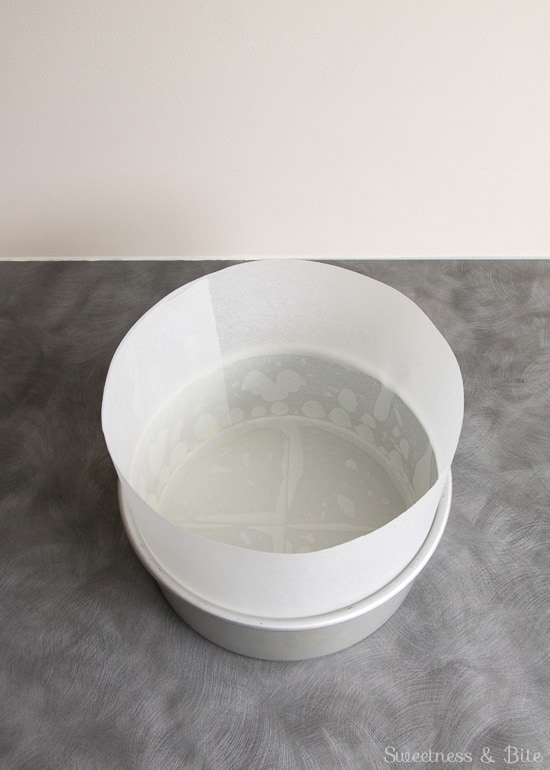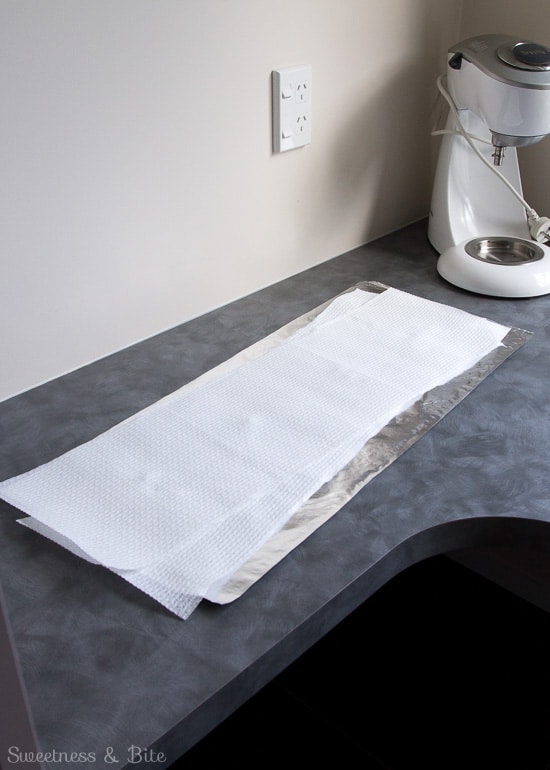How to Make DIY Cake Strips
This post may contain affiliate links to products I recommend. I receive a small commission at no cost to you if you make a purchase using my link.
If you’ve ever been disappointed by a cake with dry crusty edges, and you’d love to bake level cakes that require less trimming, then you’re definitely going to want to learn how to make DIY cake strips!

How do you feel about dry cakes? It’s the worst, right? You don’t hear someone come back from a party and announce that they really enjoyed that lovely dry cake with crusty edges that needed to be washed down with a litre of electrolyte water. Ugh.
So I think we can agree that no one likes a dry cake, and one handy technique to prevent dry cakes is to use baking strips on your cake.
If you’ve never used cake strips before then don’t worry, I’ll tell you what you need to know, and show you how to make DIY cake strips with foil and paper towels.
What Are Baking Strips?
Baking strips, also known as cake strips, are strips that you dampen and then wrap around the outside of your cake pan to insulate the cake, and help to slow down the browning on the edges, allowing them to stay soft. They also help the cakes rise evenly and stay flat on top, making levelling the cake much easier!
There are ready-made cake strips available to purchase, or you can easily make your own cake strips at home.
DIY cake strips can be made from many different materials. Some people like to just cut old towels into strips and wrap them around the cake pan, others use strips of other fabrics. To do this you just wrap the damp fabric around the outside of the pan and secure it with safety pins.
While the wet towel method is a bit quicker, I don’t like the smell of wet material in the oven, so I like to make my homemade baking strips with damp paper towels wrapped in foil, which is what I’ll be showing in this tutorial.
DIY cake strips are also great because you can adjust the size and length to fit any cake pan, and to accommodate odd-shaped pans as well.
When Should I Use Baking Strips?
Baking strips are especially useful when baking cakes that require a lower oven temperature and longer baking time. I use them mostly for chocolate mud cakes (including my white chocolate and caramel mud cakes) and rich fruit cakes. But any cake that browns quickly on the edges can benefit from cake strips, for example, cakes with a high ratio of sugar or those with fresh or dried fruit, which can burn easily on the edges.
The cake strips give the cake more time to bake in the middle before the outside of the cake dries out.
Foil Lids for Cakes
Another useful trick to prevent over-browning of a cake is to make a little foil ‘lid’ to protect the top of the cake.
I used to just place a flat piece of foil on top of the cake, but the fan in our oven would blow it off. Then I realised I could form the foil around the base of a cake pan, and make a perfect little foil hat to adorn the tin and protect the cake from the sun. Er, oven.
For denser cakes, like mud cakes, you can use a foil lid right from the start of baking, and it will help your cake rise more evenly and helps prevent cake doming. Cake domes happen when the top crust of the cake forms before the middle of the cake is finished baking. Steam tries to escape as the cake bakes, and it has to push up the top of the cake, often cracking the crust to escape.
Or you can slip it on later in baking if you check the cake and it looks like it’s getting a bit dark.
I don’t recommend using a lid for the full baking time for lighter cakes, as they can end up with a steamed-pudding kind of texture if they’re covered for the whole time. But those cakes can often brown quickly on top, so it’s handy to have a foil lid on hand to pop on for the last 5-10 minutes of baking.
Making the strips and hats adds a little extra time to the baking process, but is so worth it to avoid trimming off half of your cake to get rid of the dry bits!
How to Make DIY Cake Strips
Make sure you do these steps to make the cake strips and line your baking pan before you start mixing up your cake batter. Once the cake batter is mixed it should go into the pan and into the oven as soon as possible.
What you’ll need:
Non-stick baking paper (baking parchment)
Aluminium foil (aka tin foil, or aluminum foil, if you’re in the US)
Paper towels (choose heavy-duty ones that won’t break down when wet)
Oil spray
A large knife
Metal binder clips
Scissors

To Make a Foil Lid
If you’re making a foil lid then do this first, before lining the tin.
Take a square of foil that is large enough to cover the tin with an overhang on the edges. For larger pans, you may need to use two overlapping pieces of foil.
Fold over each of the edges of the foil.

Place it over the upturned cake tin and press down to form the foil over the tin.
If you’re making these for a square cake pan, do the same, but fold down the edges over the sides of the pan, and then fold the corners around to the side.

Remove the lid from the tin and set it aside for later. Or wear it so that the aliens can’t read your thoughts while you bake. Whatever floats your spaceship.
Line the Cake Pan
Start by measuring out a piece of baking paper long enough to fit around the circumference of your tin. (Tip: If you are lining two tins that are different sizes, make the strip long enough to fit the larger tin, and when you split the paper into two then you can trim one piece down to fit the smaller tin.) Tear off another piece of baking paper big enough to fit the base of the tin.
Take the long strip and fold it in half lengthwise. Run your fingernail along the fold. Slide the knife between the two sides and slide it along the fold to cut it. You’re basically just using the knife to split the paper along the fold.


If you are only lining one tin then set aside the other length of paper for next time.
Draw around the base of the tin onto the smaller piece of baking paper. Fold the circle into quarters. If you have trouble seeing the lines to line them up, try placing the paper onto a white or light-coloured surface, the pencil lines should show up better. Cut along the line and unfold the circle.

Spray the tin lightly with oil (or rub with softened butter). Place the long strip of baking paper into the tin and unroll it around the sides of your cake pan, adjusting it up or down as necessary.


Spray the overlapping end with oil to adhere it. Place the circle of baking paper on the bottom of the tin and smooth out any air bubbles.

Make the Baking Strips
My cake pans are 3″ tall, so I like to use tall baking strips. If you are using shorter layer cake pans, you can adjust the width of the cake strip to match the height of your cake pan by cutting down the foil and paper towels to suit.
Tear off a piece of foil long enough to wrap around the tin with a 10cm or so overlap. Tear off (or cut) two strips of paper towel the same length.
Fold the foil in half lengthwise and then unfold.

Lay one strip of paper towel on top of the other and fold it in half lengthwise.
Roll or fold them up, then saturate the towels with cold water and squeeze out the excess water very lightly – just until they no longer drip all over your bench and/or floor. They should still be quite wet.


Lay the towel along one side of the foil, and fold the other side of the foil over.
Fold the edges in (trim or fold the paper towels if they stick out too far, you should be able to fold the foil over at least once.)


Fold over the top edge of the foil, and then fold it over again to seal. We’re done folding now, promise. It’s not origami….

Place the baking strip with that folded edge on the bottom and facing towards the tin, and wrap the strip around the tin.

Pull the strip tight and secure it in place with the metal clips. If you don’t have binder clips you could use a large paper clip (just not one coated with plastic – it’ll melt!)


If you are lining a square tin the concept is basically the same, but you will need to crease the strips at the corners. Make sure you crease it all the way up above the tin – if your cake rises above the edge of the tin then the strip will help it keep its shape.
Run a finger around the top of the cake strip to smooth out any lumps and bumps. If your cake rises above the level of the tin then it may take on any odd shapes the strip makes.

Snip the top edge of the strip in a few different spots around the tin, this lets a little of the steam out as the moisture in the paper towels evaporates and stops the strips from puffing out due to trapped steam, and distorting the top of your cake. Trust me on this one, it took me a few wiggly cakes to realise it.

Now you can make your cake batter and fill the tin. If using the foil lid then place this over the top before putting the cake in the oven.

Ok, ok, it looks a little ridiculous, like the Tin Man is baking Dorothy a birthday cake, but I’m sure Dorothy hates dry cake almost as much as tornadoes and will appreciate the effort!
Once your cake comes out of the oven carefully remove the clips (they’ll be hot!) and remove the cake strips.
If the strips dry out completely during cooking and start smelling burnt, then you can remove them before the cake is done – they will have done most of their job protecting the cake by the time they dry out. If you suspect the cake has a lot longer still to bake then you can put new strips on, or re-wet (or replace) the paper towels in the strips – just use oven mitts to remove the hot metal clips, and let the strips cool a bit before you handle them! (And the cake should go back in the oven while you refresh the strips).
Baking Time
Keep in mind that when using these strips your cake will most likely take longer to bake than the recipe states and you will need to use your best judgement on when to start checking it. If you’re having trouble working out if the cake is cooked all the way through, then check out this post for tips.
Reusing DIY Cake Strips
You can re-use these foil cake strips more than once, just carefully open up the foil and either re-wet the same paper towels or replace them with fresh ones.
Need More Cake Tips?
My How to Keep Your Cakes Moist post has more tips for keeping your cake moist during and after baking.
How to Tell if a Cake is Done shows you three ways to test you cake to make sure it is baked all the way through.
And my Ultimate Guide to Sugar Syrup will tell you all about using simple syrup on cake layers, to add moisture back into a cake, and also to add heaps more delicious flavour! It’s the baker’s secret to ensuring a moist cake.
As always, if you have any questions you know where to find me (hint: the comments below are a good place to start looking. I don’t camouflage well. It’s the ginger hair, I suspect.)
~Natalie
x
